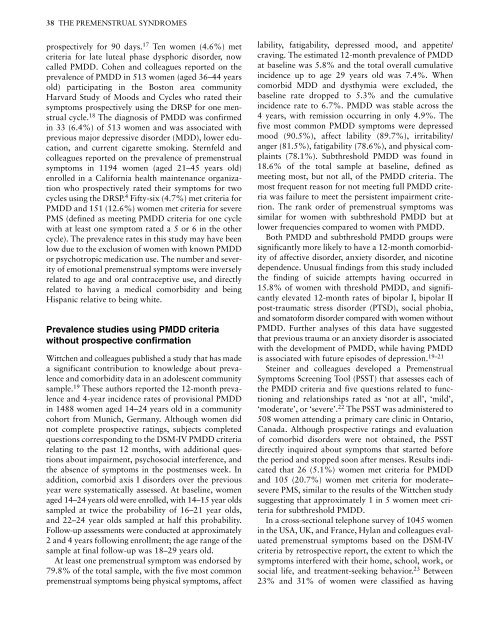Premenstrual Syndromes : PMS and PMDD - Rutuja :: The site ...
Premenstrual Syndromes : PMS and PMDD - Rutuja :: The site ...
Premenstrual Syndromes : PMS and PMDD - Rutuja :: The site ...
Create successful ePaper yourself
Turn your PDF publications into a flip-book with our unique Google optimized e-Paper software.
38 THE PREMENSTRUAL SYNDROMES<br />
prospectively for 90 days. 17 Ten women (4.6%) met<br />
criteria for late luteal phase dysphoric disorder, now<br />
called <strong>PMDD</strong>. Cohen <strong>and</strong> colleagues reported on the<br />
prevalence of <strong>PMDD</strong> in 513 women (aged 36–44 years<br />
old) participating in the Boston area community<br />
Harvard Study of Moods <strong>and</strong> Cycles who rated their<br />
symptoms prospectively using the DRSP for one menstrual<br />
cycle. 18 <strong>The</strong> diagnosis of <strong>PMDD</strong> was confirmed<br />
in 33 (6.4%) of 513 women <strong>and</strong> was associated with<br />
previous major depressive disorder (MDD), lower education,<br />
<strong>and</strong> current cigarette smoking. Sternfeld <strong>and</strong><br />
colleagues reported on the prevalence of premenstrual<br />
symptoms in 1194 women (aged 21–45 years old)<br />
enrolled in a California health maintenance organization<br />
who prospectively rated their symptoms for two<br />
cycles using the DRSP. 4 Fifty-six (4.7%) met criteria for<br />
<strong>PMDD</strong> <strong>and</strong> 151 (12.6%) women met criteria for severe<br />
<strong>PMS</strong> (defined as meeting <strong>PMDD</strong> criteria for one cycle<br />
with at least one symptom rated a 5 or 6 in the other<br />
cycle). <strong>The</strong> prevalence rates in this study may have been<br />
low due to the exclusion of women with known <strong>PMDD</strong><br />
or psychotropic medication use. <strong>The</strong> number <strong>and</strong> severity<br />
of emotional premenstrual symptoms were inversely<br />
related to age <strong>and</strong> oral contraceptive use, <strong>and</strong> directly<br />
related to having a medical comorbidity <strong>and</strong> being<br />
Hispanic relative to being white.<br />
Prevalence studies using <strong>PMDD</strong> criteria<br />
without prospective confirmation<br />
Wittchen <strong>and</strong> colleagues published a study that has made<br />
a significant contribution to knowledge about prevalence<br />
<strong>and</strong> comorbidity data in an adolescent community<br />
sample. 19 <strong>The</strong>se authors reported the 12-month prevalence<br />
<strong>and</strong> 4-year incidence rates of provisional <strong>PMDD</strong><br />
in 1488 women aged 14–24 years old in a community<br />
cohort from Munich, Germany. Although women did<br />
not complete prospective ratings, subjects completed<br />
questions corresponding to the DSM-IV <strong>PMDD</strong> criteria<br />
relating to the past 12 months, with additional questions<br />
about impairment, psychosocial interference, <strong>and</strong><br />
the absence of symptoms in the postmenses week. In<br />
addition, comorbid axis I disorders over the previous<br />
year were systematically assessed. At baseline, women<br />
aged 14–24 years old were enrolled, with 14–15 year olds<br />
sampled at twice the probability of 16–21 year olds,<br />
<strong>and</strong> 22–24 year olds sampled at half this probability.<br />
Follow-up assessments were conducted at approximately<br />
2 <strong>and</strong> 4 years following enrollment; the age range of the<br />
sample at final follow-up was 18–29 years old.<br />
At least one premenstrual symptom was endorsed by<br />
79.8% of the total sample, with the five most common<br />
premenstrual symptoms being physical symptoms, affect<br />
lability, fatigability, depressed mood, <strong>and</strong> appetite/<br />
craving. <strong>The</strong> estimated 12-month prevalence of <strong>PMDD</strong><br />
at baseline was 5.8% <strong>and</strong> the total overall cumulative<br />
incidence up to age 29 years old was 7.4%. When<br />
comorbid MDD <strong>and</strong> dysthymia were excluded, the<br />
baseline rate dropped to 5.3% <strong>and</strong> the cumulative<br />
incidence rate to 6.7%. <strong>PMDD</strong> was stable across the<br />
4 years, with remission occurring in only 4.9%. <strong>The</strong><br />
five most common <strong>PMDD</strong> symptoms were depressed<br />
mood (90.5%), affect lability (89.7%), irritability/<br />
anger (81.5%), fatigability (78.6%), <strong>and</strong> physical complaints<br />
(78.1%). Subthreshold <strong>PMDD</strong> was found in<br />
18.6% of the total sample at baseline, defined as<br />
meeting most, but not all, of the <strong>PMDD</strong> criteria. <strong>The</strong><br />
most frequent reason for not meeting full <strong>PMDD</strong> criteria<br />
was failure to meet the persistent impairment criterion.<br />
<strong>The</strong> rank order of premenstrual symptoms was<br />
similar for women with subthreshold <strong>PMDD</strong> but at<br />
lower frequencies compared to women with <strong>PMDD</strong>.<br />
Both <strong>PMDD</strong> <strong>and</strong> subthreshold <strong>PMDD</strong> groups were<br />
significantly more likely to have a 12-month comorbidity<br />
of affective disorder, anxiety disorder, <strong>and</strong> nicotine<br />
dependence. Unusual findings from this study included<br />
the finding of suicide attempts having occurred in<br />
15.8% of women with threshold <strong>PMDD</strong>, <strong>and</strong> significantly<br />
elevated 12-month rates of bipolar I, bipolar II<br />
post-traumatic stress disorder (PTSD), social phobia,<br />
<strong>and</strong> somatoform disorder compared with women without<br />
<strong>PMDD</strong>. Further analyses of this data have suggested<br />
that previous trauma or an anxiety disorder is associated<br />
with the development of <strong>PMDD</strong>, while having <strong>PMDD</strong><br />
is associated with future episodes of depression. 19–21<br />
Steiner <strong>and</strong> colleagues developed a <strong>Premenstrual</strong><br />
Symptoms Screening Tool (PSST) that assesses each of<br />
the <strong>PMDD</strong> criteria <strong>and</strong> five questions related to functioning<br />
<strong>and</strong> relationships rated as ‘not at all’, ‘mild’,<br />
‘moderate’, or ‘severe’. 22 <strong>The</strong> PSST was administered to<br />
508 women attending a primary care clinic in Ontario,<br />
Canada. Although prospective ratings <strong>and</strong> evaluation<br />
of comorbid disorders were not obtained, the PSST<br />
directly inquired about symptoms that started before<br />
the period <strong>and</strong> stopped soon after menses. Results indicated<br />
that 26 (5.1%) women met criteria for <strong>PMDD</strong><br />
<strong>and</strong> 105 (20.7%) women met criteria for moderate–<br />
severe <strong>PMS</strong>, similar to the results of the Wittchen study<br />
suggesting that approximately 1 in 5 women meet criteria<br />
for subthreshold <strong>PMDD</strong>.<br />
In a cross-sectional telephone survey of 1045 women<br />
in the USA, UK, <strong>and</strong> France, Hylan <strong>and</strong> colleagues evaluated<br />
premenstrual symptoms based on the DSM-IV<br />
criteria by retrospective report, the extent to which the<br />
symptoms interfered with their home, school, work, or<br />
social life, <strong>and</strong> treatment-seeking behavior. 23 Between<br />
23% <strong>and</strong> 31% of women were classified as having


